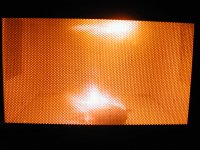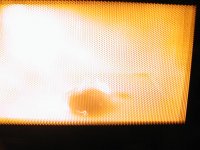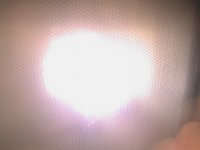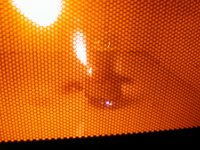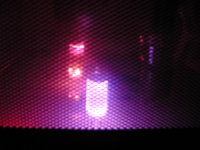Oh, and to answer the weight question, my son and I carried them up from the basement with difficulty.
The official weight...180lbs each!
They are on some pretty sturdy end tables my wife picked out to match the media center. I sat on each of the tables (I weigh 230lbs) and moved around and they are solid, and didn't budge, but I know I'm going to be worrying about them for a while. Not exactly proper amp stands...but then again, she has been very understanding of my Midlife Crisis.
The official weight...180lbs each!
They are on some pretty sturdy end tables my wife picked out to match the media center. I sat on each of the tables (I weigh 230lbs) and moved around and they are solid, and didn't budge, but I know I'm going to be worrying about them for a while. Not exactly proper amp stands...but then again, she has been very understanding of my Midlife Crisis.
Magz,
Congratulations...Been following the build from the beginning...Just awesome.
Now I'm just waiting on the invitation for us to all come over for a listen
Evan
Congratulations...Been following the build from the beginning...Just awesome.
Now I'm just waiting on the invitation for us to all come over for a listen
Evan
Awesome. Congratulations. It's been fun following your build process.
So.... What's next? 2x 833 in push-pull? Because, clearly, 200 W SET is not enough. 🙂
~Tom
So.... What's next? 2x 833 in push-pull? Because, clearly, 200 W SET is not enough. 🙂
~Tom
IIRC, the filament pins of DHT's of that size get pretty hot. That is one benefit of cooling from underneath. However, adding 'chimneys' require static pressure capacity that 'muffin-style' fans don't have...hence the squirrel-cage blowers typical in some RF amps where the noise is accepted as normal.
...and now almost completely off-topic...some of you may wish to leave the thread...
Was that SOS pad with or without the soap? What did you do (you're still blonde, right?) with the plasma?
OH, the fun I recall with microwave ovens when I was first exposed to them in school! (Don't try this at home!) Low profile aluminum foil ashtrays produced no arcing in microwave oven...so close to oven metal surface (waveguide walls) there isn't enough electric field for fireworks. Standard steel cafeteria napkin holders about 6" high are tall enough for nice lightning display (oven audibly disagreed with us, however). Skipped soda can experiments - past researchers' anecdotal reports eliminated our curiosity.
Moved on from inanimate conductors to foodstuffs.
Single-serve hot dog relish packets provided by vendo-chow service irradiated for 5 minutes produced the foulest odor I've ever documented in a microwave oven test...could clear the entire student unit building in minutes!
 They changed brands and air quality distress levels could not be repeated. 😡 Ketchup/catsup produced unremarkable effects.
They changed brands and air quality distress levels could not be repeated. 😡 Ketchup/catsup produced unremarkable effects.
Canada Mints produce awesome phase change sculptures but are hell to clean out of the oven. A paper plate would have been considerate but we were primarily interested in conducting research. Vendo-chow service was displeased with resilience of post-combustion residue and resistance to normal cleaning solvents. Spontaneous confection combustion not a popular experiment. Duly noted.
A friend who is an electrical engineer shattered three jars of butterscotch ice cream sundae topping in a microwave and gave up. #1 - he didn't notice the label had foil. #2 Label removed, reason for shattering unknown. #3, Label removed, observed stuff boiled up to the rim of the jar and emitting visible glow or corona and shattering before he could reach for the Stop button. He theorized it carbonized and became conductive. He just put future jars in a pot of hot water to warm to desired temperature (to put on cold ice cream...I don't understand).
Decades later, passing the magic of modifying foodstuffs with non-ionizing radiation for artistic purposes on to the next generation...we have hosted exchange students from other countries, and the bizarre seasonal US marshmallow candy creatures known as Peeps with 20-30 second dose of full power 2.45 GHz create a lot of entertainment, captured on video to share online.
😱
...and now almost completely off-topic...some of you may wish to leave the thread...
The circuit can deliver a lot of power to the tube in normal operation, but if the tube experiences a high VSWR due to the user operating the oven with nothing inside (or the blonde one nuking a SOS pad to make plasma)
Was that SOS pad with or without the soap? What did you do (you're still blonde, right?) with the plasma?
OH, the fun I recall with microwave ovens when I was first exposed to them in school! (Don't try this at home!) Low profile aluminum foil ashtrays produced no arcing in microwave oven...so close to oven metal surface (waveguide walls) there isn't enough electric field for fireworks. Standard steel cafeteria napkin holders about 6" high are tall enough for nice lightning display (oven audibly disagreed with us, however). Skipped soda can experiments - past researchers' anecdotal reports eliminated our curiosity.
Moved on from inanimate conductors to foodstuffs.
Single-serve hot dog relish packets provided by vendo-chow service irradiated for 5 minutes produced the foulest odor I've ever documented in a microwave oven test...could clear the entire student unit building in minutes!

 They changed brands and air quality distress levels could not be repeated. 😡 Ketchup/catsup produced unremarkable effects.
They changed brands and air quality distress levels could not be repeated. 😡 Ketchup/catsup produced unremarkable effects.Canada Mints produce awesome phase change sculptures but are hell to clean out of the oven. A paper plate would have been considerate but we were primarily interested in conducting research. Vendo-chow service was displeased with resilience of post-combustion residue and resistance to normal cleaning solvents. Spontaneous confection combustion not a popular experiment. Duly noted.

A friend who is an electrical engineer shattered three jars of butterscotch ice cream sundae topping in a microwave and gave up. #1 - he didn't notice the label had foil. #2 Label removed, reason for shattering unknown. #3, Label removed, observed stuff boiled up to the rim of the jar and emitting visible glow or corona and shattering before he could reach for the Stop button. He theorized it carbonized and became conductive. He just put future jars in a pot of hot water to warm to desired temperature (to put on cold ice cream...I don't understand).
Decades later, passing the magic of modifying foodstuffs with non-ionizing radiation for artistic purposes on to the next generation...we have hosted exchange students from other countries, and the bizarre seasonal US marshmallow candy creatures known as Peeps with 20-30 second dose of full power 2.45 GHz create a lot of entertainment, captured on video to share online.

😱
Nice job! (You must have a nice job as well to feed this habit). I'm inspired to resume construction of my puny 6AS7G/6080 and 6C33C-B/6S33S-V projects.
the BASS is the biggest shock - these amps kick the crap out of my 500WPC Class D monoblocks in the bass!
Awesome job on the build - very jealous of your skills!
Anyway, without feedback in the 833 monobloc, what's the estimated damping factor? Surely the Class D has order of magnitude more DF than the 833s.😕
Wild guess TI lab people came up with an alternative shielding material for their own EMI/EMC lab work...I see an occasional op amp app note published by various IC mfrs discussing measured performance. Something ferrous is often desirable and mu-metal type materials, for all their benefits are fussier to get in a hurry as well as costlier.
Magz,
Congratulations...Been following the build from the beginning...Just awesome.
Now I'm just waiting on the invitation for us to all come over for a listen
Evan
You got it. Drop me a PM.
Awesome. Congratulations. It's been fun following your build process.
So.... What's next? 2x 833 in push-pull? Because, clearly, 200 W SET is not enough. 🙂
~Tom
Next is a break. This obsession, err.. project, has consumed almost all of my spare time and brain power over the last year. I tend to be a bit OCD (OK, a LOT) when in the middle of something like this, and honestly, if I was my wife I would have killed me by now. She also mentioned something about spending our money on a new kitchen and furnace this year...
Honestly, though, I do NOT need any more power. It's truly effortless how these things drive those speakers. I haven't gotten past -10dB on the volume knob of my preamp, and that was LOUD Johnny Lang and Gary Moore blues guitar...wake the neighbors loud!
IIRC, the filament pins of DHT's of that size get pretty hot. That is one benefit of cooling from underneath. However, adding 'chimneys' require static pressure capacity that 'muffin-style' fans don't have...hence the squirrel-cage blowers typical in some RF amps where the noise is accepted as normal.
I've heard that. However, if you place your hand over the top of the glass cylinder, you can clearly feel a steady rush of hot air blowing around the tube and out of the cylinder, and the temperature of the hottest part of the chassis was only 50 deg C after about two hours of playing last night, so it seems to be doing a good job pulling the hot air from the chassis and directing it up around the tube. I calculated the diameter of the chimney to be big enough that the cross-sectional area of space around the tube was slightly greater than the cross sectional area of the fan surface, so there wasn't a lot of compression taking place - it seems to have worked so far. I'll monitor the situation for a while just to make sure.
Sound-wise, I can hear the fans slightly from my listening position when the cylinders are in place and the room is completely quiet - I think the cylinders channel the sound directly up and off the ceiling, rather than letting it spread in all directions as it does with them off. It's completely negligible, though, when any music is playing.
Last edited:
I know those bottles are big, but just look at the Size of them 'in context'!
Wow!
Congratulations Sir 🙂
Wow!
Congratulations Sir 🙂
........ She also mentioned something about spending our money on a new kitchen and furnace this year...
Congratulations on a superb build!



Im a little confused about your wife needing a new furnace though. I thought the amps would heat the house just fine?
Seriously though I wonder what the combined power draw is for both monoblocks playing at good volume versus at idle. Do you have a wall watt meter?
Awesome job on the build - very jealous of your skills!
Anyway, without feedback in the 833 monobloc, what's the estimated damping factor? Surely the Class D has order of magnitude more DF than the 833s.😕
The class D has about 30X more damping factor overall, but it doesn't seem to make much of a difference in this case. The RSIIb's are nominal 4 ohms, but dip to 1.6 - 2.0 ohms in the high treble (9kHz and up), but there isn't much power up there. Highs sound GREAT! In fact, they were a tad harsh with class D, and that is completely gone now.
In the bass, the speakers help me out, I think, in that below 100Hz the impedance rises steadily to about 14 ohms at 40Hz and is still about 10 ohms at 20Hz, so down in the bass, where the damping factor is really needed, the situation is much better. No dips in the bass region at all. The design is open baffle for the mids and highs and tightly sealed (by me, stock it was leaky) bass cabinet. The crossover is external in a separate box with 12 gauge air core inductors for the bass (considering going to 8 gauge in the future).
The point you make about damping factor is why I'm surprised at the bass response of this pairing. I was anticipating having to add some feedback but held off until I listened, and to me it doesn't seem necessary. Maybe after some more listening I'll discover a weakness, but it really doesn't sound bloated or blurred to me.
I see, the increasing impedance at LF certainly helps, here is my rough estimate:
ra for 833 at 2.3kV, 160mA ~ 10k
ZR for 12k:4 ~ 3000
Zo = 10k/3k = 3.33
DF = Zspkr/Zo = 14/3.33 = 4.24
Not bad at all without NFB.
ra for 833 at 2.3kV, 160mA ~ 10k
ZR for 12k:4 ~ 3000
Zo = 10k/3k = 3.33
DF = Zspkr/Zo = 14/3.33 = 4.24
Not bad at all without NFB.
I see, the increasing impedance at LF certainly helps, here is my rough estimate:
ra for 833 at 2.3kV, 160mA ~ 10k
ZR for 12k:4 ~ 3000
Zo = 10k/3k = 3.33
DF = Zspkr/Zo = 14/3.33 = 4.24
Not bad at all without NFB.
I think the ra for the 833C under those conditions is probably closer to 8k but I haven't measured it, and the measured ZR (using an LCR meter) of the OPT is actually 12950/4, and at this point, I'm ready to toss out the numbers and just listen!
Seriously though I wonder what the combined power draw is for both monoblocks playing at good volume versus at idle. Do you have a wall watt meter?
No, I don't. They seem to survive just fine on a dedicated 20A circuit with the preamp and source, so it's not a worry at this point.
Seriously though I wonder what the combined power draw is for both monoblocks playing at good volume versus at idle. Do you have a wall watt meter?
I think that since it is a class A amplifier the power draw is always the same.
My best congratulation for the 8th Wonder of the World !!
Was that SOS pad with or without the soap?
With. The plain ones make a lot of sparks and not much else. The soap burns, then the smoke ionizes and becomes plasma.
What did you do (you're still blonde, right?) with the plasma?
UH.....put it in my pocket!!!! NOT
Watched it and listened to and took pictures of it for several minutes until it eventually burned a hole through the oven floor and started lighting up the backyard. The sound it made was wicked and it attracted a bit of attention from the neighbors. The orange then purple then white glow lit up the whole back yard. When it burned through the oven floor, I hit the KILL button. Would I nuke a 6146? Only a dead one without a plate cap. Fire shot off the wire that used to connect to the plate cap. It started a plasma. 0A2's glow orange, 2D21's glow purple. No plasma was generated.
Note:
I used to amuse the neighborhood on July 4th and New Years Eve with my home made fireworks and electrical pyrotechnics. The local cops seemed to overlook the "destructive device" and illegal fireworks laws on those two days until 9-11. After that day, I was told that my experiments would no longer be tolerated.
It was custom to sacrifice a microwave oven, a PC, or even a big box store stereo on these days. Once we did a NOS boosted lawnmower. We would talk a walk around the neighborhood and pick up something on trash day.....then return it to the trash when properly used up. I always had ample safety systems to keep the fun from getting out of hand.
Attachments
- Home
- Amplifiers
- Tubes / Valves
- The Midlife Crisis - My 833C Amp Build

